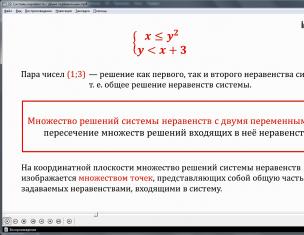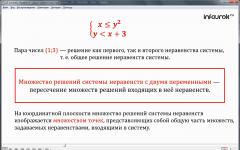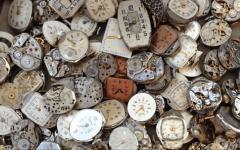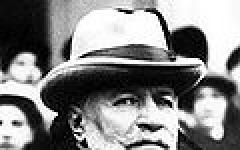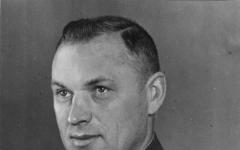Purpose of the lesson: Understand what a participle phrase is, learn to distinguish it from a single participle. Lesson objectives: Repeat the spelling of vowels in case endings of participles. Find out what a participle phrase is. Find out how many words can be included in a participial phrase. Find out what part of speech the participial phrase is. Find out which word in the sentence the participial phrase refers to. Learn to distinguish a participial phrase from a single participle (exercise 69).

Spelling vowels in case endings of nouns. Waking up child; slightly swaying reeds; under the...yellow...clouds; disappear into the darkened sky; under the opening parach.. volume; along the alley strewn with yellowed leaves; in the gradually fading flame of a fire; shining sparks of silver and white frost.

In a phrase, a participle can act as a Dependent word of the Main word (to which we ask a question) (from which we ask a question) Distribute these phrases into two groups: 1. Participle is a dependent word. 2. Communion is the main word. - A seeded field sown with peas; - illuminated by a light bulb, illuminated hall; - a person who is interested in music, a passionate person; - creeping fog over the river; - a detained criminal caught on the street.

Participle is a dependent word. Communion is the main word. Sown field. Illuminated hall. An enthusiastic person. Creeping fog. Detained criminal. Sown with peas. Illuminated by a light bulb. Passionate about music. Creeping over the river. Detained on the street.



Participial phrase and defined word. The participial phrase always refers A) to the word being defined (we ask a question from it to the participial phrase); B) The word being defined can be expressed by a noun or a personal pronoun; participial phrase 2. - the word being defined (noun)

Participial phrase and defined word Participial phrase + defined word - the noun to which it refers. 4. From the word being defined, we ask a question to the participial phrase!

Conclusions: What is a participle phrase? How many dependent words can there be in a participial phrase? What is the name of the word to which the participial phrase refers? What part of speech can the word being defined be expressed by? What function does the word being defined perform in a participial phrase? Let's learn to distinguish a participial phrase with a qualified word from a single participle.

Slide 2
A participle is a special form of a verb with the following characteristics:
1.Denotes the attribute of an object by action and answers the questions: what? what is he doing, what has he done?, what has he done? 2. Has the morphological characteristics of a verb and an adjective.
Slide 3
Signs of verb and adjective:
Aspect (SV and NSV), - transitivity (the sign is relevant for active participles), - reflexivity, - tense (present and past). - voice (active and passive). - gender, - number, - case (for full participles), - completeness / brevity (for passive participles only).
Slide 4
Fourth extra 1. Winter, hibernating, frozen, open. 2. Raging, silent, fulfilled, mirror. 3. Flying, amazing, descending, surprised. 4. Printed, opened, sent, solemn. Mark the suffixes of the participles
Slide 5
Is that the case with you? 1. Winter, hibernating, frozen, open. 2.Raging, silent, fulfilled, mirror. 3.Flying, amazing, descending, surprised. 4. Printed, opened, sent, solemn. - What part of speech are the highlighted words?
Slide 6
Suffixes:
Slide 7
Write down the participles, distributing them into columns: 1-real; 2- passive. Choose defining words for them.
Planted, appeared, stepped, open, playing, explaining, broken, built, extinguished, sown, falling, fallen.
Slide 8
Let's check ourselves:
Active The sun has appeared the night has fallen a playing child explaining the teacher a dying fire falling leaves Passive Planted tree open door broken glass built house sown field fallen tree
Slide 9
Form and write active present participles and highlight their suffixes (repeat the spelling rule for verbs I and II conjugations.
Sow, glue, build, wash, trouble, heal, write, breathe, hold, knit, lay, doze, divide, fight, be famous, hope, count, hide, hesitate, be heard.
Slide 10
Write all possible forms of participles for each verb.
To send, to send, to send, to lie, to sleep, to go, to lie down.























Enable Effects
1 of 24
Disable effects
View similar
Embed code
VKontakte
Classmates
Telegram
Reviews
Add your review
Abstract for the presentation
The participial phrase is the main theme of this presentation work on the Russian language. Based on explanatory pictures and specific examples of comparison of sentence models, schoolchildren should quickly master this new topic.
- We study the participial phrase
- Pictures - helpers
- Illustrative examples
- Game "Proofreader"
- Assignment for independent work
To conduct a lesson by a teacher
Format
pptx (powerpoint)
Number of slides
Audience
Words
Abstract
Present
Purpose
Slide 1
Participial phrase
Slide 2
King WHO
- who reads
- which tells
- who laughs
- who dances
Slide 3
- who studies
- who thinks
- who threw
- who ran away
- who galloped away
Slide 4
Slide 5
- who laughs
- who dances
- which tells
- who reads
Slide 6
- who studies
- who threw
- who ran away
- who galloped away
- who thinks
Slide 7
- participial phrase.
- definition.
- Remember that a participial phrase does not include the noun it defines.
A problem solved by a student.
Fleeing from the mountains
Slide 8
Complicated cheating.
1) The wind blowing from the sea was getting stronger and stronger. 2) The foliage torn from the trees began to swirl in a whirlwind and began to rise upward. 3) The cape rising above the surface of the lake looked like an iron.
Slide 9
Slide 10
The Mausoleum of Halicarnassus, which was ranked among the seven wonders of the world, is very interesting.
The Halicarnassus Museum, listed as one of the Seven Wonders of the World, is very interesting.
Slide 12
According to some evidence, it was built by Artemisia, who was the sister and at the same time the wife of the Carian king Mausolus.
According to some evidence, it was built by Artemisia, who was the sister and at the same time the wife of the Carian king Mausolus.
Slide 13
- This monument was made of wonderful marble that glowed in the dark.
- This monument was made of wonderful marble that glowed in the dark.
Slide 14
On the ground floor, which was a rectangular closed room, there was a burial chamber.
On the ground floor, which was a rectangular closed room, there was a burial chamber.
Slide 15
- A temple was placed on the blank walls of the second floor, which was surrounded by a colonnade.
- A temple surrounded by a colonnade was placed on the blank walls of the second floor.
Slide 16
The multi-stage pyramid housed a marble quadriga, which was controlled by those whose ashes rested below.
The multi-stage pyramid housed a marble quadriga, controlled by those whose ashes rested below.
QUADRIGA - a two-wheeled chariot drawn by four horses.
Slide 17
For about two thousand years, from a height of sixty meters, the royal family surveyed the city, which gradually changed at the foot of the mausoleum.
For about two thousand years, from a height of sixty meters, the royal family surveyed the city, which gradually changed at the foot of the mausoleum.
Slide 18
- Similar buildings, which were erected for noble persons, began to be called mausoleums.
- Such buildings, erected for noble persons, began to be called mausoleums.
Slide 19
Game "Proofreader"
Slide 20
The famous tomb of Mausolus was located in Asia Minor, which shocked the inhabitants of the ancient world with its size and splendor.
Key: The famous tomb of Mausolus, which shocked the inhabitants of the ancient world with its size and splendor, was located in Asia Minor.
Slide 21
Mausolus, who did not trust the Persian architects, announced a competition among Greek architects, in which Pytheas and Satyr won.
Slide 22
Key: The tomb surrounded by thirty-nine columns attracted particular attention.
Slide 23
HOMEWORK paragraph 12, exercise No. 74
Slide 24
Task for 3
Place punctuation marks. Indicate the test words in brackets.
Task for 4
Place punctuation marks and emphasize participial phrases. Indicate the test words in brackets.
1) Leap year (_________) spent at home is more pleasant than bone (_________) broth. 2) People who complain hourly (________) are so unhappy (_________), sad (___________), terrible (_________). 3) The artist who hates (_________) looking around will not find the picturesque (_________) meadow beautiful.
4) A peer (_________) performing a Spanish dance (_________) drinks Icelandic coffee (_________) during breaks. 5) The agency (__________) providing dangerous (________) services will not be chosen by my beautiful (_________) friends.
Task for 5
Place punctuation marks, insert missing letters, and underline participial phrases.
1) A leap year spent at home is more pleasant than braid broth. 2) People who complain every hour are so unhappy, sad, terrible. 3) The picturesque meadow will not seem beautiful to the artist who looks around him hatefully. 4) A nickname performing a Spanish dance drinks Spanish coffee during breaks. 5) My beautiful friends will not choose an agency that provides dangerous services.
View all slides
Abstract
Lesson topic: "Participial phrase"
Lesson type:
Lesson type:
Technology: gaming technology element
Target:
Know
Be able to:
Equipment: cards, ICT
Lesson progress
Organizational moment
Frontal survey
How do they change?
Learning new material
1) Teacher's word
Target:
He told her:
I am a king who loves.
Loving,” she corrected.
The years I have left...
The remaining...
I want to dedicate to you.
2) Educational work
A participle with dependent words is called - participial phrase.
In a sentence, the participial phrase is a member of the sentence - definition.
If the participial phrase comes after the word being defined, then it is highlighted in the letter with commas.
solved by student |
||
Fleeing from the mountains |
Training exercise
1) Complicated cheating
2) The teacher's word.
Exercise:
Sample:
Consolidation
Game "Proofreader"
Task: correct grammatical errors.
Key: Mausolus, who did not trust the Persian architects, announced a competition among Greek architects, in which Pytheas and Satyr won.
The tomb surrounded by 39 columns attracted particular attention.
(
Summing up the lesson
Teacher's word.
Homework
§12, exercise No. 74
Lesson topic: "Participial phrase"
Lesson type: lesson on learning new material
Lesson type: lesson-trip using a linguistic fairy tale
Technology: gaming technology element
Target: 1) introduce students to the concept of “participial phrase” and its syntactic synonym – a sentence with the conjunctive word “which”;
2) cultivate respect for the native language;
3) develop correct writing skills.
Know: identifying features of participial phrase
Be able to: see the participle phrase, correctly determine its boundaries, replace constructions with the words “which” with the participial phrase.
Equipment: cards, ICT
Lesson progress
Organizational moment
Frontal survey
(Students’ story about communion.)
What part of speech do we call participle?
What types and tenses are there of participles?
How do they change?
What are they in a sentence?
They change according to cases. How are participles declined?
How to distinguish a participle from an adjective?
1. Participle is an independent part of speech, which denotes a characteristic of an object in action that manifests itself in time and answers the questions: what? Which? Which? Which?
2. Participles are of the owl and nes type, present and past tense. They change by numbers, cases and only in the singular by gender.
3. In a sentence, participles are usually modifiers, less often predicates.
4. Declend like adjectives
5. a) replace the adjective (qualitative) with a synonym, and the participle with a combination of words WHICH + the verb from which it is formed in n or n tense. For example: a sparse forest is sparse, a thinning forest is a forest that is thinning out.
B) can be distinguished by morpheme characteristics - adjectives can have suffixes -uch, yuch, participles ashch, yashch For example, padlock, hanging tassels
Learning new material
1) Teacher's word
Target: Explain to students the purpose of the lesson.
Guys, we continue our acquaintance with the sacrament, today you will learn an amazing story about King WHOM and the princess from the kingdom of PARTICIPLES. We will look at how participles and participle phrases are formed, and we will even try to act as a proofreader and detect errors in the use of participial phrases.
In a distant country, in ancient times, there was a king WHO ruled. He was so proud of himself that he strictly ordered all his subjects to praise his name everywhere. Even his courtiers had unusual names - who studies, who tells, who laughs, who reads, who thinks, who dances, but even those who left service at the court did not lose their names: who abandoned, who galloped away, who ran, who left, who fell silent, who was tired.
Life was sad in the kingdom, where every child was a WHO from birth, every baby was a WHO, every child was a WHO...
The sun that rose, the flowers that bloomed, the birds that chirped, did not please the inhabitants, who were tired of the whims of King WHO.
And then one day a miracle happened: the king fell in love with a beautiful princess from the kingdom of PARTICIPLES.
He told her:
I am a king who loves.
Loving,” she corrected.
I am the one who admires you.
Admiring, she echoed.
The years I have left...
The remaining...
I want to dedicate to you.
“Okay,” answered the princess, “but just let each resident decide for himself who he is: the one who believed, or the one who believed, the one who knows, or the one who knows...
Imagine how happy the king’s subjects were!
2) Educational work
Let's see what happened to the names of the king's subjects after the intervention of Princess COMMUNION. (Students write participles in their notebooks and highlight suffixes)
3) What is a participle phrase?
A participle with dependent words is called - participial phrase.
In a sentence, the participial phrase is a member of the sentence - definition.
If the participial phrase comes after the word being defined, then it is highlighted in the letter with commas.
solved by student |
||
Fleeing from the mountains |
Remember that a participial phrase does not include the noun it defines.
Training exercise
1) Complicated cheating
Copy, indicating the boundaries of the participial phrase and adding missing punctuation marks.
1. The wind blowing from the sea was getting stronger and stronger. 2. The foliage, torn from the trees, swirled in a whirlwind and began to rise upward. 3. The cape, rising above the surface of the lake, looked like an iron.
2) The teacher's word. We continue our journey. Of course, King WHO is very famous, but still not as famous as the famous Mausolus of Halicarnassus. Let's get acquainted with the amazing history of the architectural monument, which was the 7th wonder of the world and do the exercise.
Exercise: replace complex sentences with simple sentences complicated by participial phrases.
Sample:The Mausoleum of Halicarnassus, which was ranked among the seven wonders of the world, is very interesting.-The Halicarnassus Museum, listed as one of the Seven Wonders of the World, is very interesting.
This is an architectural masterpiece that was built in the 4th century BC. (This is an architectural masterpiece built in the 4th century BC.)
According to some evidence, it was built by Artemisia, who was the sister and at the same time the wife of the Carian king Mausolus. (According to some evidence, it was built by Artemisia, who was the sister and at the same time the wife of the Carian king Mausolus.)
This monument was made of wonderful marble that glowed in the dark. (This monument was made of wonderful marble that glowed in the dark)
On the ground floor, which was a rectangular closed room, there was a burial chamber. (On the first floor, which was a rectangular closed room, there was a burial chamber.)
A temple was placed on the blank walls of the second floor, which was surrounded by a colonnade. (A temple surrounded by a colonnade was placed on the blank walls of the second floor.)
The multi-stage pyramid housed a marble quadriga, which was controlled by those whose ashes rested below. (The multi-stage pyramid housed a marble quadriga, controlled by those whose ashes rested below.)
About two thousand from a height of sixty meters, the royal family surveyed the city, which gradually changed at the foot of the mausoleum. (About two thousand from a height of sixty meters, the royal family surveyed the city, which was gradually changing at the foot of the mausoleum.)
Similar buildings, which were erected for noble persons, began to be called mausoleums. (Such buildings erected for noble persons began to be called mausoleums.)
QUADRIGA - a two-wheeled chariot drawn by four horses.
Consolidation
Game "Proofreader"
Task: correct grammatical errors.
The famous tomb of Mausolus was located in Asia Minor, which shocked the inhabitants of the ancient world with its size and splendor ( hint: the participial phrase is in the wrong position in relation to the word being defined)
Key: The famous tomb of Mausolus, which shocked the inhabitants of the ancient world with its size and splendor, was located in Asia Minor.
Mausolus, who did not trust the Persian architects, announced a competition among Greek architects, in which Pytheas and Satyr won. ( Hint: the participle does not agree with a specific noun)
Key: Mausolus, who did not trust the Persian architects, announced a competition among Greek architects, in which Pytheas and Satyr won.
The tomb surrounded by 39 columns attracted particular attention.
(Hint: the word being defined should not be part of the participial phrase)
Key: The tomb surrounded by 39 columns attracted particular attention.
Summing up the lesson
Teacher's word. Today we started studying one of the most interesting topics in the Russian language course. We tried to construct sentences with participial phrases and correct errors.
Homework
§12, exercise No. 74
Completing tasks on cards.
Download abstractPresentation “Participial phrase. Isolating participial phrases with commas” is intended for 7th grade students. This presentation includes an introduction to the participial phrase and the conditions for isolating the participial phrase. The presentation consists of 13 slides and can be used at the initial stage of familiarization with this topic. A lesson using this presentation will help you study the material in a fun way using examples taken from N. Gogol’s work “Taras Bulba”. The clarity of the examples and the presence of thematic illustrations will help you master a fairly complex topic.
Download:
Preview:
To use presentation previews, create a Google account and log in to it: https://accounts.google.com
Slide captions:
Lesson topic: Participial phrase. Separate the participial phrase with commas. Teacher of Russian language and literature: Nikolaeva Lyudmila Ivanovna.
Distributive dictation. Write down the phrases in two columns: 1 - adjective, 2 - participle. From a moving column, red buttons, a blushing sunset, hot milk, dark fabric, in darkening water, reflected in a lake, an overgrown pond,
Lesson objectives: understand what a participial phrase is; find participle phrases in sentences; consider the conditions for isolating the participial phrase; show the role of the participial phrase in speech.
compare the phrases written in each column. a student reading reading in the evening a book read read by a girl a blossoming snowdrop blossoming in the spring - What do you notice about them in common? What's the difference? - Determine in which cases the participle is the main word, and in which it is a dependent word.
A participle with dependent words is called a participial phrase
Find the participial phrase in the sentences and add punctuation marks. - With these words old Bulba greeted his two sons who studied at the Kyiv Bursa. - Bulba led his sons into the little room from where two beautiful servant girls in red monasteries quickly ran out, cleaning the rooms.
Everyone sat down, not even including the boys who stood respectfully at the door. The moon from the heights of the sky has long illuminated the entire courtyard filled with sleeping people... Their faces, still slightly tanned, became prettier and whiter...
Find the grammatical error in the sentence when using the participial phrase. Fix her. - Deprived of her last hope, the poor old woman sadly trudged into the hut. -One poor mother did not sleep; she leaned to the head of her dear sons who were lying nearby. -The poor old woman, sitting on the bench, already accustomed to such actions of her husband, looked sadly.
Test “Test yourself”: 1) Find the definition of participial phrase. a) two or more participles in a sentence, b) a participle with dependent words, c) a participle with a qualifying word. 2) What is a participial phrase in a sentence? a) subject b) definition c) addition. 3) Indicate the correct condition for the isolation of a participial phrase: a) stands before the word being defined, b) stands after the word being defined, c) always, regardless of the place in the sentence.
4) Find a sentence in which the participial phrase is separated by commas: a) Through my father’s eyes, I saw the majestic world of my native nature unfolding before me. b) The heavy horse-hide door of the yurt rose up in the wall. c) A fox carefully made its way through the withered grass, yellowed by rain and wind. 5) Find the sentence with a punctuation error. a) Human life can be compared to a stream that originates in the bowels of the earth. b) A flock of guys stood at a fence made from signs. c) A tall geologist walked ahead, wearing a sun-bleached suit.
Correct answers: 1)-b 2)-b 3)-b 4)-c 5)-c
Reflection “Ladder of Success” Try to determine how well you have learned new knowledge using the “Ladder of Success.” You choose: - red color if you have difficulty; - Green color, if you have learned new knowledge, but find it difficult to apply it in practice; - yellow color, if you have acquired new knowledge and learned to apply it in practice.
The one who chose the yellow color - point 12, will write 8 sentences with participial phrases from the literary text. - Who chose green - paragraph 12, exercise. 74. -The one who chose the color red - paragraph 12, exercise, No. 77.


